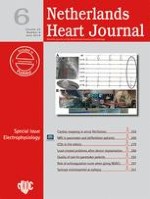Transient loss of consciousness (T-LOC) is defined as an abrupt, self-limiting complete loss of consciousness [
1]. Cardiac syncope is caused by reduced global cerebral perfusion due to a sudden decrease in cardiac output. Arrhythmia and structural heart disease such as aortic stenosis and cardiomyopathy are the most important cardiac causes of syncope. Recognising cardiac syncope is of utmost importance because of all patients with T-LOC, the ones with cardiac syncope have the highest likelihood of subsequent sudden death [
7]. Kapoor et al. [
8] showed in 1983 that in the 12 months following presentation with cardiac syncope, sudden death was found to be six times more common than in patients with noncardiac syncope. It is unknown how often cardiac syncope is misdiagnosed as epilepsy.
The patient of this case report suffered from syncope induced by a ventricular tachycardia as a consequence of noncompaction cardiomyopathy (NCCM). NCCM is a relatively new and frequently overlooked diagnosis [
9,
10]. Even with the help of modern imaging modalities, such as contrast echocardiography and MRI, diagnosing NCCM can be difficult [
10]. The clinical spectrum of NCCM shows a highly variable clinical presentation, ranging from asymptomatic to severely symptomatic with end-stage heart failure, lethal arrhythmias, and/or thromboembolic events [
11]. Most cases are inherited, with a dominant inheritance pattern. There is a high prevalence of, mostly asymptomatic, cardiac disease (26 %) among first- and second-degree family members of patients with NCCM [
12]. This warrants genetic counselling, DNA diagnostics, and cardiological family screening and offers an opportunity for early intervention [
12,
13]. There is no consensus on the treatment of NCCM. Caliskan et al. [
14] showed in a relatively large group of NCCM patients that ICD therapy for primary or secondary prevention of SCD was appropriate in both groups supporting the application of ICD in these patients. However, although ICD seems to be an effective option for preventing SCD, data on the long-term follow-up of NCCM patients remain scarce.
